2014 MERCEDES-BENZ SLS AMG GT COUPE snow chains
[x] Cancel search: snow chainsPage 9 of 290

Distance recorder
............................. 152
see Odometer
see Trip odometer
Door control panel
Overview .......................................... 33
Doors
Automatic locking (on-board
computer) ...................................... 159
Automatic locking (switch) .............. .70
Central locking/unlocking
(SmartKey) ...................................... .62
Display message .................... 184, 186
Emergency locking ........................... 71
Emergency unlocking .......................71
Important safety notes ....................68
Opening (from inside) ......................69
Draft stop ............................................. 80
Drinking and driving .........................135
Drinks holder see Cup holder
Drive program
Automatic ...................................... 126
Manual .......................................... .127
SETUP (on-board computer) ..........161
Drive program display ......................123
Driver's door see Doors
Driving abroad
Mercedes-Benz Service .................223
Symmetrical low bea m.................... 96
Driving lamps
see Daytime running lamps
Driving on flooded roads ..................137
Driving safety systems ABS (Anti-lock Braking System) .......54
ADAPTIVE BRAKE ............................. 58
BAS (Brake Assist System) ..............55
EBD (electronic brake force
distribution) ..................................... 57
ESP ®
(Electronic Stability Program) .56
ETS (Electronic Traction System) .....55
Important safety information ...........54
Overview .......................................... 54
Driving systems
AMG adaptive sport suspension
system ........................................... 140
Blind Spot Assist ............................ 145 Cruise control
................................ 138
Display message ............................ 180
PARKTRONIC ................................. 141
Rear view camera .......................... 144
Driving tips
AMG ceramic high-performance
compound brake system ...............137
Brakes ........................................... 135
Break-in period .............................. 118
Downhill gradient ........................... 135
Drinking and driving .......................135
Driving abroad ................................. 96
Driving in winter ............................ .137
Driving on wet roads ......................137
Exhaust check ............................... 135
Fuel ................................................ 134
General .......................................... 134
Hydroplaning ................................. 137
Icy road surfaces ........................... 137
Limited braking efficiency on
salted road s................................... 136
Snow chains .................................. 251
Symmetrical low bea m.................... 96
Wet road surface ........................... 136
DVD audio (on-board computer) ......155
DVD video (on-board computer) ......155 E
EASY-ENTRY feature Activating/deactivating .................160
Function/notes ................................ 89
EASY-EXIT feature
Crash-responsive ............................. 90
Function/notes ................................ 89
Switching on/off ........................... 160
EBD (electronic brake force
distribution)
Display message ............................ 166
Function/notes ................................ 57
Electronic Stability Program
see ESP ®
(Electronic Stability Program)
Electronic traction control system
see ETS ............................................ 55
Emergency release
Driver's door .................................... 71
Trunk ............................................... 74
Vehicle ............................................. 71 Index
7
Page 15 of 290

Refrigerant (air-conditioning
system)
.......................................... 282
Washer fluid .................................. .284
Settings
Factory (on-board computer) .........160
On-board computer .......................157
Setting the air distribution ...............110
Setting the airflow ............................111
SETUP (on-board computer) .............161
Shift ranges ....................................... 127
Side impact air bag .............................41
Side marker lamp (display
message) ............................................ 176
Side windows Cleaning ......................................... 227
Convenience closing feature ............77
Convenience opening feature ..........76
Important safety information ...........75
Opening/closing .............................. 75
Opening/closing (all) .......................76
Problem (malfunction) .....................78
SmartKey ............................................. 68
Changing the battery .......................65
Changing the programming .............63
Checking the battery .......................65
Convenience closing feature ............77
Convenience opening feature ..........76
Display message ............................ 185
Door central locking/unlocking .......62
Loss ................................................. 66
Mechanical key ................................ 64
Opening/closing soft top .................80
Positions (ignition lock) .................119
Problem (malfunction) .....................66
Starting the engine ........................120
Unlocking/locking vehicle ...............68
SmartKey positions
KEYLESS-GO start function ............119
Snow chains ...................................... 251
Socket Glove box ...................................... .204
Sockets
Center console .............................. 204
Points to observe before use .........203
Soft top
Cleaning ......................................... 226
Display message ............................ 184
Important safety notes ....................78Opening/closing (SmartKey)
...........80
Opening/closing (with soft-top
switch) ............................................. 79
Problem (malfunction) .....................82
Relocking ......................................... 80
wind screen ..................................... 80
Soft-top switch .................................... 79
Specialist workshop ............................ 22
Speed, controlling see Cruise control
Speedometer
Activating/deactivating the
additional speedometer .................158
Digital ............................................ 152
In the Instrument cluster .................27
Selecting the unit of measurement 157
see Instrument cluster
SPORT handling mode
Warning lamp ................................. 193
SRS
see SRS (Supplemental Restraint
System)
SRS (Supplemental Restraint
System)
Display message ............................ 173
Introduction ..................................... 37
Warning lamp ................................. 194
Warning lamp (function) ................... 37
Standing lamps
Display message ............................ 176
Switching on/off .............................. 97
Starting (engine) ................................ 120
Steering wheel Adjusting (electrically) .....................89
Button overview ............................... 29
Buttons (on-board computer) ......... 151
Cleaning ......................................... 229
Important safety notes ....................88
Paddle shifters ............................... 125
Storing settings (memory function) .. 92
Stopwatch (RACETIMER) ................... 161
Stowage areas ................................... 200
Stowage compartments Armrest (under) ............................. 201
Center console .............................. 201
Cup holders ................................... 202
Glove box ...................................... .200
Important safety information .........200 Index
13
Page 19 of 290
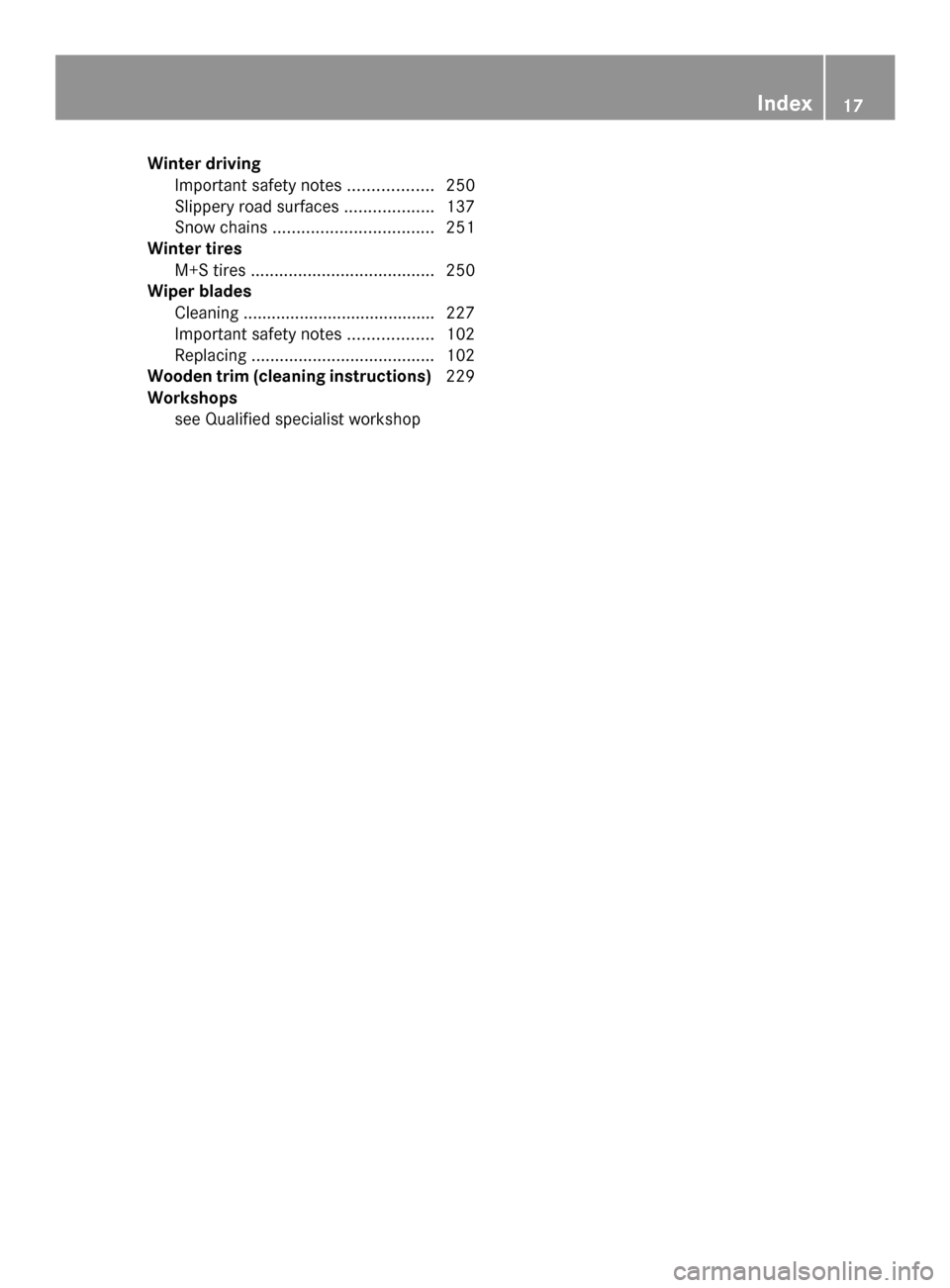
Winter driving
Important safety notes ..................250
Slippery road surfaces ...................137
Snow chains .................................. 251
Winter tires
M+S tires ....................................... 250
Wiper blades
Cleaning ......................................... 227
Important safety notes ..................102
Replacing ....................................... 102
Wooden trim (cleaning instructions) 229
Workshops see Qualified specialist workshop Index
17
Page 56 of 290

X
Position Top Tether belt 0085. Comply with
the manufacturer's installation
instructions when doing so.
X Hook Top Tether hook 0087into Top Tether
anchorage 0044.
Ensure that:
R Top Tether hook 0087is hooked into Top
Tether anchorage 0044as shown.
R Top Tether belt 0085is not twisted.
When Top Tether hook 0087is connected, the
child restraint system can be secured.
X Install the child restraint system.
X Tension Top Tether belt 0085. Comply with
the manufacturer's installation
instructions when doing so.
The child restraint system with Top Tether
belt 0085has been removed:
X Slide cover 0043onto Top Tether
anchorage 0044. Driving safety systems
Overview of driving safety systems
In this section, you will find information about
the following driving safety systems:
R ABS (Anti-lock BrakingSystem)
R BAS (Brake AssistSystem)
R ESP ®
(Electronic StabilityProgram)
R EBD ( Electronic Brake force Distribution)
R ADAPTIVE BRAKE Important safety notes
If you fail to adapt your driving style or
become distracted, the driving safety
systems can neither reduce the risk of
accident nor override the laws of physics.
Driving safety systems are merely aids
designed to assist driving. You are
responsible for the distance to the vehicle in
front, for vehicle speed and for braking in
good time. Always adapt your driving style to
suit the prevailing road and weather
conditions and maintain a safe distance from
the vehicle in front. Drive carefully.
The driving safety systems described only
work as effectively as possible when there is
adequate contact between the tires and the
road surface. Please pay special attention to
the notes on tires, recommended minimum
tire tread depths, etc. (Y page 248).
i In wintry driving conditions, always use
winter tires (M+S tires) and if necessary,
snow chains. Only in this way will the
driving safety systems described in this
section work as effectively as possible. ABS (Anti-lock Braking System)
Important safety notes i
Observe the "Important safety notes"
section (Y page 54). G
WARNING
If ABS is faulty, the wheels could lock when
braking. The steerability and braking
characteristics may be severely impaired.
Additionally, further driving safety systems
are deactivated. There is an increased danger
of skidding and accidents.
Drive on carefully. Have ABS checked
immediately at a qualified specialist
workshop.
When ABS is malfunctioning, other systems,
including driving safety systems, will also
become inoperative. Observe the information 54
Driving safety systemsSafety
Page 58 of 290
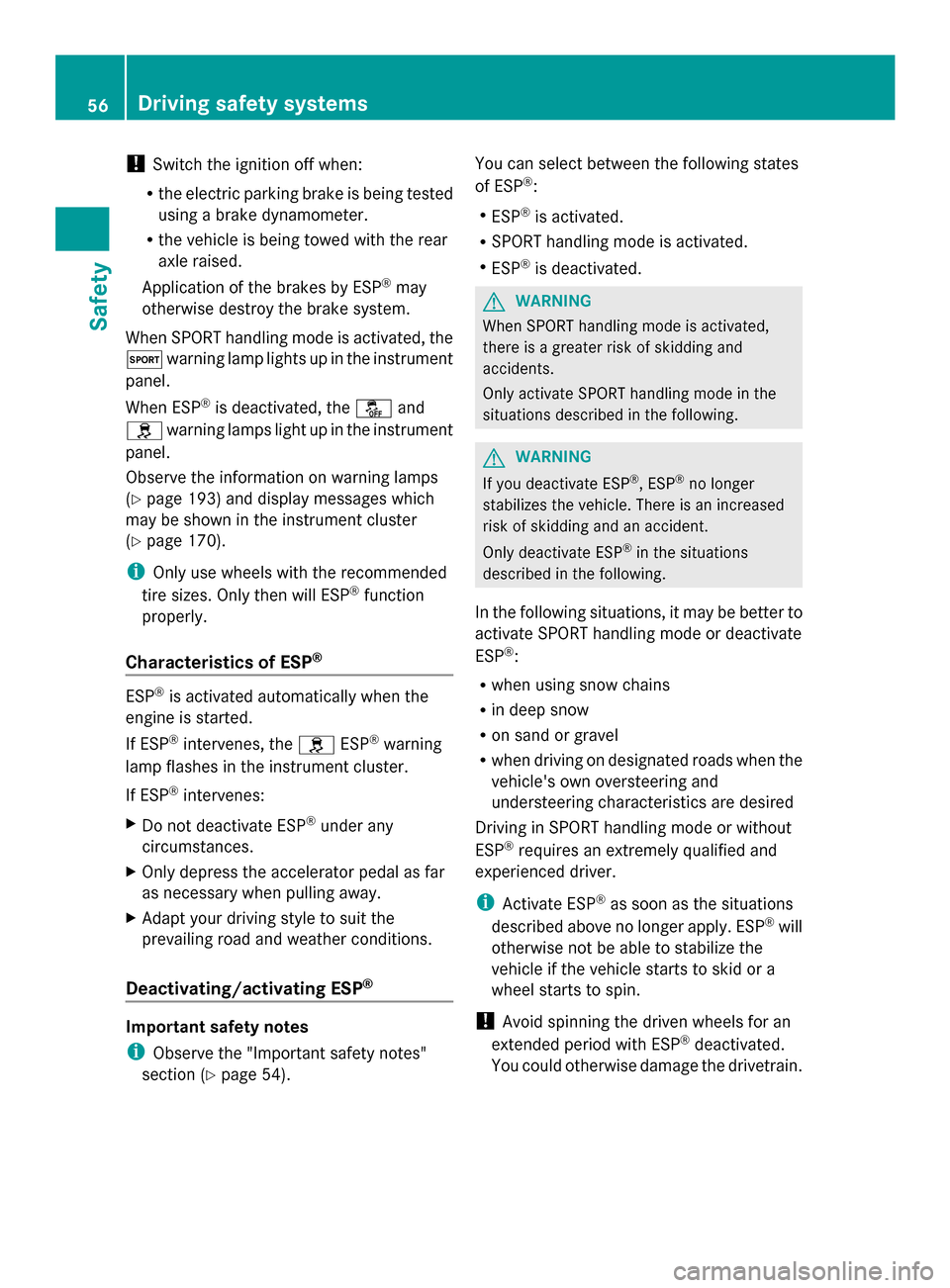
!
Switch the ignition off when:
R the electric parking brake is being tested
using a brake dynamometer.
R the vehicle is being towed with the rear
axle raised.
Application of the brakes by ESP ®
may
otherwise destroy the brake system.
When SPORT handling mode is activated, the
0074 warning lamp lights up in the instrument
panel.
When ESP ®
is deactivated, the 00BBand
0089 warning lamps light up in the instrument
panel.
Observe the information on warning lamps
(Y page 193) and display messages which
may be shown in the instrument cluster
(Y page 170).
i Only use wheels with the recommended
tire sizes. Only then will ESP ®
function
properly.
Characteristics of ESP ®ESP
®
is activated automatically when the
engine is started.
If ESP ®
intervenes, the 0089ESP®
warning
lamp flashes in the instrument cluster.
If ESP ®
intervenes:
X Do not deactivate ESP ®
under any
circumstances.
X Only depress the accelerator pedal as far
as necessary when pulling away.
X Adapt your driving style to suit the
prevailing road and weather conditions.
Deactivating/activating ESP ®Important safety notes
i
Observe the "Important safety notes"
section (Y page 54). You can select between the following states
of ESP
®
:
R ESP ®
is activated.
R SPORT handling mode is activated.
R ESP ®
is deactivated. G
WARNING
When SPORT handling mode is activated,
there is a greater risk of skidding and
accidents.
Only activate SPORT handling mode in the
situations described in the following. G
WARNING
If you deactivate ESP ®
, ESP ®
no longer
stabilizes the vehicle. There is an increased
risk of skidding and an accident.
Only deactivate ESP ®
in the situations
described in the following.
In the following situations, it may be better to
activate SPORT handling mode or deactivate
ESP ®
:
R when using snow chains
R in deep snow
R on sand or gravel
R when driving on designated roads when the
vehicle's own oversteering and
understeering characteristics are desired
Driving in SPORT handling mode or without
ESP ®
requires an extremely qualified and
experienced driver.
i Activate ESP ®
as soon as the situations
described above no longer apply. ESP ®
will
otherwise not be able to stabilize the
vehicle if the vehicle starts to skid or a
wheel starts to spin.
! Avoid spinning the driven wheels for an
extended period with ESP ®
deactivated.
You could otherwise damage the drivetrain. 56
Driving safety systemsSafety
Page 140 of 290
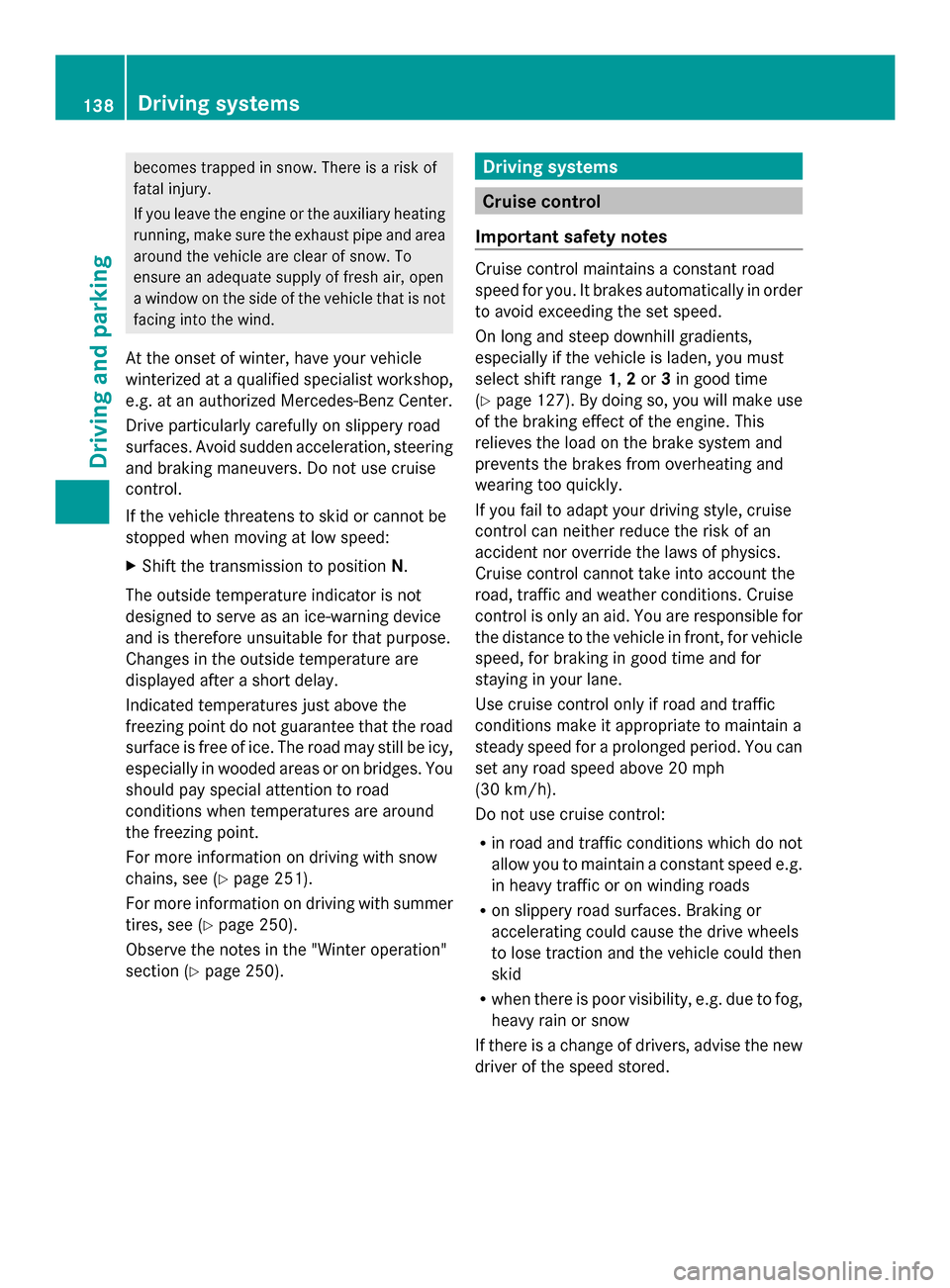
becomes trapped in snow. There is a risk of
fatal injury.
If you leave the engine or the auxiliary heating
running, make sure the exhaust pipe and area
around the vehicle are clear of snow. To
ensure an adequate supply of fresh air, open
a window on the side of the vehicle that is not
facing into the wind.
At the onset of winter, have your vehicle
winterized at a qualified specialist workshop,
e.g. at an authorized Mercedes-Benz Center.
Drive particularly carefully on slippery road
surfaces. Avoid sudden acceleration, steering
and braking maneuvers. Do not use cruise
control.
If the vehicle threatens to skid or cannot be
stopped when moving at low speed:
X Shift the transmission to position N.
The outside temperature indicator is not
designed to serve as an ice-warning device
and is therefore unsuitable for that purpose.
Changes in the outside temperature are
displayed after a short delay.
Indicated temperatures just above the
freezing point do not guarantee that the road
surface is free of ice. The road may still be icy,
especially in wooded areas or on bridges. You
should pay special attention to road
conditions when temperatures are around
the freezing point.
For more information on driving with snow
chains, see (Y page 251).
For more information on driving with summer
tires, see (Y page 250).
Observe the notes in the "Winter operation"
section (Y page 250). Driving systems
Cruise control
Important safety notes Cruise control maintains a constant road
speed for you. It brakes automatically in order
to avoid exceeding the set speed.
On long and steep downhill gradients,
especially if the vehicle is laden, you must
select shift range
1,2or 3in good time
(Y page 127). By doing so, you will make use
of the braking effect of the engine. This
relieves the load on the brake system and
prevents the brakes from overheating and
wearing too quickly.
If you fail to adapt your driving style, cruise
control can neither reduce the risk of an
accident nor override the laws of physics.
Cruise control cannot take into account the
road, traffic and weather conditions. Cruise
control is only an aid. You are responsible for
the distance to the vehicle in front, for vehicle
speed, for braking in good time and for
staying in your lane.
Use cruise control only if road and traffic
conditions make it appropriate to maintain a
steady speed for a prolonged period. You can
set any road speed above 20 mph
(30 km/h).
Do not use cruise control:
R in road and traffic conditions which do not
allow you to maintain a constant speed e.g.
in heavy traffic or on winding roads
R on slippery road surfaces. Braking or
accelerating could cause the drive wheels
to lose traction and the vehicle could then
skid
R when there is poor visibility, e.g. due to fog,
heavy rain or snow
If there is a change of drivers, advise the new
driver of the speed stored. 138
Driving systemsDriving and parking
Page 253 of 290
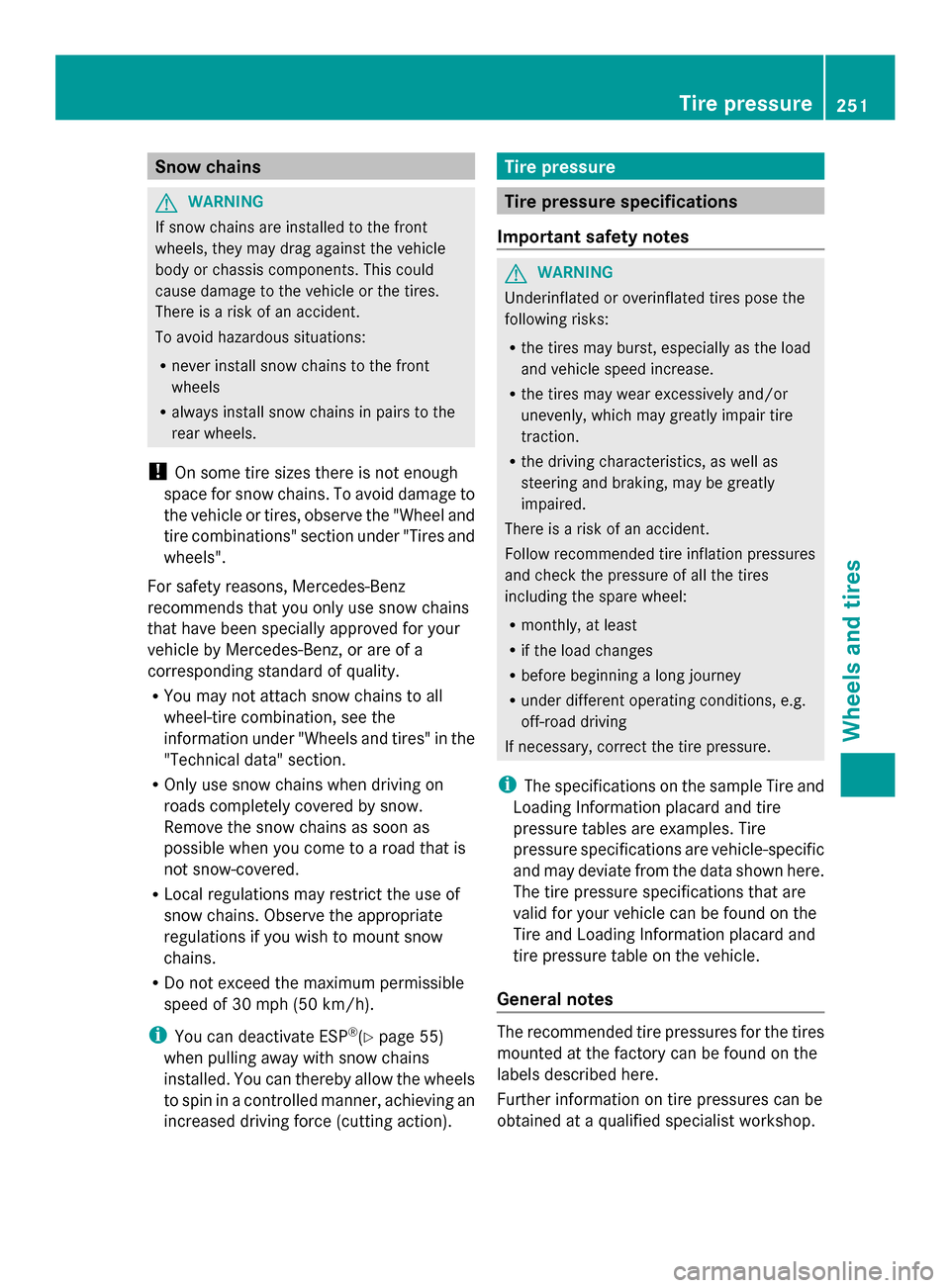
Snow chains
G
WARNING
If snow chains are installed to the front
wheels, they may drag against the vehicle
body or chassis components. This could
cause damage to the vehicle or the tires.
There is a risk of an accident.
To avoid hazardous situations:
R never install snow chains to the front
wheels
R always install snow chains in pairs to the
rear wheels.
! On some tire sizes there is not enough
space for snow chains. To avoid damage to
the vehicle or tires, observe the "Wheel and
tire combinations" section under "Tires and
wheels".
For safety reasons, Mercedes-Benz
recommends that you only use snow chains
that have been specially approved for your
vehicle by Mercedes-Benz, or are of a
corresponding standard of quality.
R You may not attach snow chains to all
wheel-tire combination, see the
information under "Wheels and tires" in the
"Technical data" section.
R Only use snow chains when driving on
roads completely covered by snow.
Remove the snow chains as soon as
possible when you come to a road that is
not snow-covered.
R Local regulations may restrict the use of
snow chains. Observe the appropriate
regulations if you wish to mount snow
chains.
R Do not exceed the maximum permissible
speed of 30 mph (50 km/h).
i You can deactivate ESP ®
(Y page 55)
when pulling away with snow chains
installed. You can thereby allow the wheels
to spin in a controlled manner, achieving an
increased driving force (cutting action). Tire pressure
Tire pressure specifications
Important safety notes G
WARNING
Underinflated or overinflated tires pose the
following risks:
R the tires may burst, especially as the load
and vehicle speed increase.
R the tires may wear excessively and/or
unevenly, which may greatly impair tire
traction.
R the driving characteristics, as well as
steering and braking, may be greatly
impaired.
There is a risk of an accident.
Follow recommended tire inflation pressures
and check the pressure of all the tires
including the spare wheel:
R monthly, at least
R if the load changes
R before beginning a long journey
R under different operating conditions, e.g.
off-road driving
If necessary, correct the tire pressure.
i The specifications on the sample Tire and
Loading Information placard and tire
pressure tables are examples. Tire
pressure specifications are vehicle-specific
and may deviate from the data shown here.
The tire pressure specifications that are
valid for your vehicle can be found on the
Tire and Loading Information placard and
tire pressure table on the vehicle.
General notes The recommended tire pressures for the tires
mounted at the factory can be found on the
labels described here.
Further information on tire pressures can be
obtained at a qualified specialist workshop. Tire pressure
251Wheels and tires Z
Page 277 of 290
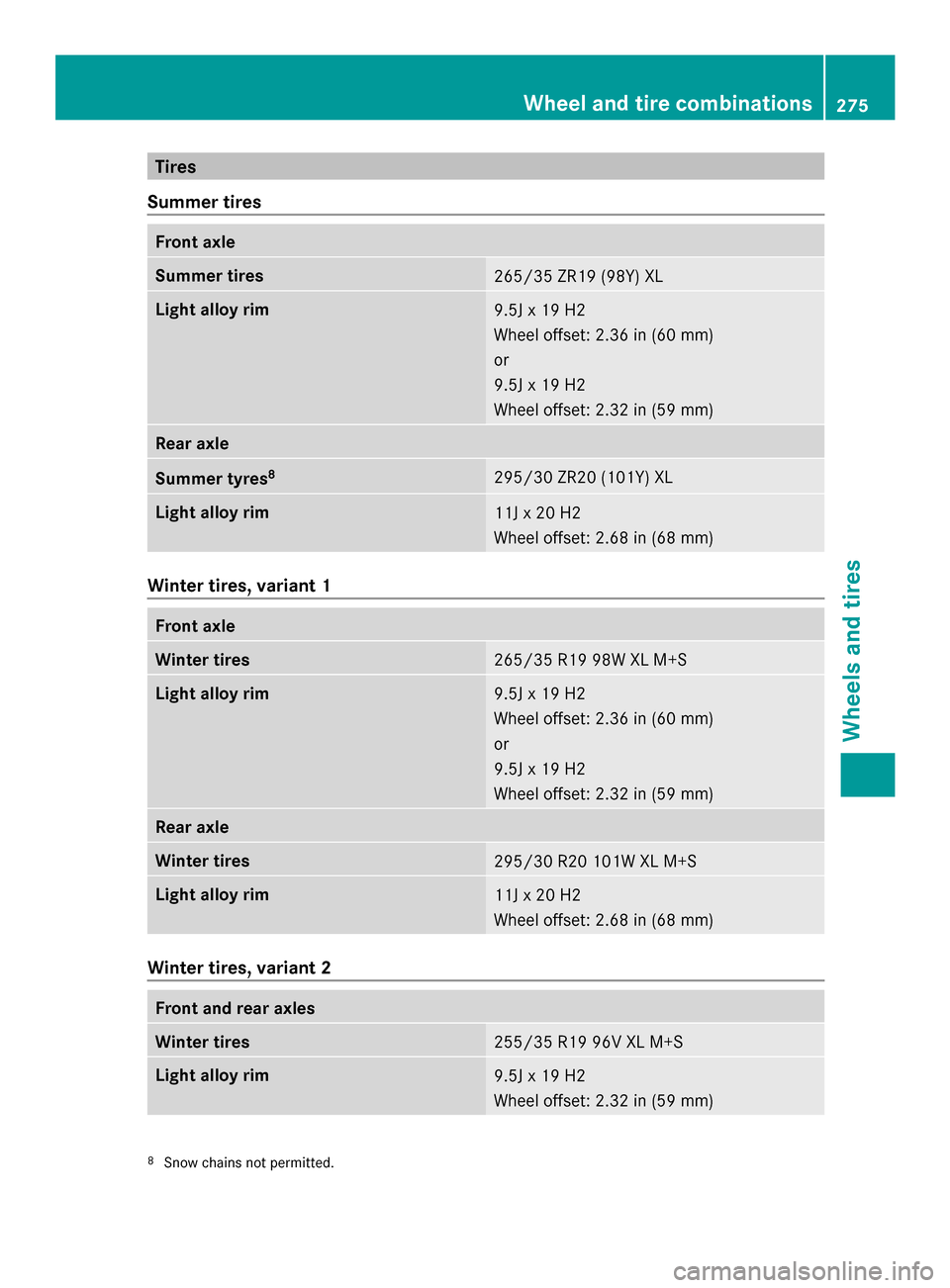
Tires
Summer tires Front axle
Summer tires
265/35 ZR19 (98Y) XL
Light alloy rim
9.5J x 19 H2
Wheel offset: 2.36 in (60 mm)
or
9.5J x 19 H2
Wheel offset: 2.32 in (59 mm)
Rear axle
Summer tyres
8 295/30 ZR20 (101Y) XL
Light alloy rim
11J x 20 H2
Wheel offset: 2.68 in (68 mm)
Winter tires, variant 1
Front axle
Winter tires
265/35 R19 98W XL M+S
Light alloy rim
9.5J x 19 H2
Wheel offset: 2.36 in (60 mm)
or
9.5J x 19 H2
Wheel offset: 2.32 in (59 mm)
Rear axle
Winter tires
295/30 R20 101W XL M+S
Light alloy rim
11J x 20 H2
Wheel offset: 2.68 in (68 mm)
Winter tires, variant 2
Front and rear axles
Winter tires
255/35 R19 96V XL M+S
Light alloy rim
9.5J x 19 H2
Wheel offset: 2.32 in (59 mm)
8
Snow chains not permitted. Wheel and tire combinations
275Wheels and tires Z